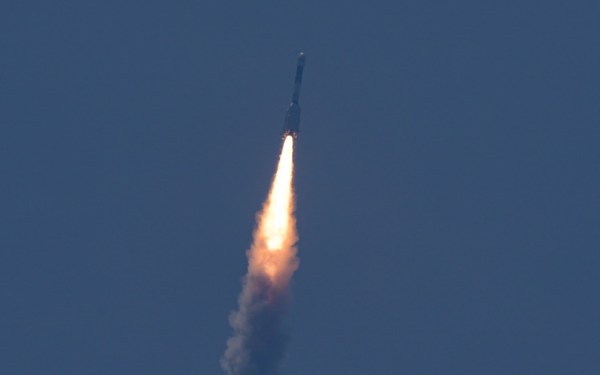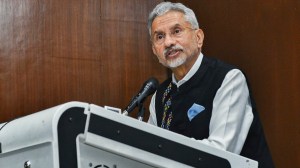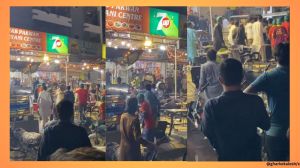- India
- International
ISRO’s new NavIC satellite launches successfully: Why a regional navigation system matters to India
Each of the seven satellites currently in the Indian Regional Navigation Satellite System (IRNSS) constellation, operationally named NavIC, weighed much less — around 1,425 kg — at liftoff. They all rode the lighter PSLV, ISRO’s workhorse launch rocket.
 ISRO's GSLV rocket carrying navigation satellite NVS-01 lifts off from the Satish Dhawan Space Centre, in Sriharikota, Monday, May 29, 2023. (PTI Photo)
ISRO's GSLV rocket carrying navigation satellite NVS-01 lifts off from the Satish Dhawan Space Centre, in Sriharikota, Monday, May 29, 2023. (PTI Photo) The Indian Space Research Organisation (ISRO) launched the first of the second-generation satellites for its navigation constellation successfully on Monday morning. The 2,232 kg satellite, the heaviest in the constellation, was launched by a Geosynchronous Satellite Launch Vehicle (GSLV) rocket that lifted off from Sriharikota at 10:42 am.
Each of the seven satellites currently in the Indian Regional Navigation Satellite System (IRNSS) constellation, operationally named NavIC, weighed much less — around 1,425 kg — at liftoff. They all rode the lighter Polar Satellite Launch Vehicle (PSLV), ISRO’s workhorse launch rocket.
 ISRO’s GSLV rocket on its way to deploy navigation satellite NVS-01 into a Geosynchronous Transfer Orbit, lifted off from the Satish Dhawan Space Centre in Sriharikota, Monday, May 29, 2023. (PTI Photo/R Senthilkumar)
ISRO’s GSLV rocket on its way to deploy navigation satellite NVS-01 into a Geosynchronous Transfer Orbit, lifted off from the Satish Dhawan Space Centre in Sriharikota, Monday, May 29, 2023. (PTI Photo/R Senthilkumar)
The last IRNSS satellite, IRNSS-1I, was launched in April 2018 to replace an older, partially defunct satellite in the constellation. IRNSS-1I was ISRO’s ninth satellite for the NavIC constellation, but is considered to be the eighth because the IRNSS-1H — launched eight months earlier in August 2017 and originally intended to replace the older satellite — was lost after the heat shield of the payload failed to open on time.
What’s new in the second-generation NavIC satellite?
As stated above, the second-generation satellite — christened NVS-01, the first of ISRO’s NVS series of payloads — is heavier. Other than that:
Atomic Clock: The satellite will have a Rubidium atomic clock onboard, a significant technology developed by India. “The space-qualified Rubidium atomic clock indigenously developed by Space Application Centre-Ahmedabad is an important technology which only a handful of countries possess,” ISRO said in a statement.

L1 signals for better use in wearable devices: The second generation satellites will send signals in a third frequency, L1, besides the L5 and S frequency signals that the existing satellites provide, increasing interoperability with other satellite-based navigation systems.
The L1 frequency is among the most commonly used in the Global Positioning System (GPS), and will increase the use of the regional navigation system in wearable devices and personal trackers that use low-power, single-frequency chips.
Longer mission life: The second-generation satellites will also have a longer mission life of more than 12 years. The existing satellites have a mission life of 10 years.
What is the significance of the atomic clock on board the NVS-01 payload?
Several of the existing satellites stopped providing location data after their onboard atomic clocks failed — this was the main reason for the launch of the replacement satellite in 2018. Since a satellite-based positioning system determines the location of objects by accurately measuring the time it takes for a signal to travel to and back from it using the atomic clocks on board, failure of clocks means the satellites are no longer able to provide accurate locations.
Currently, only four IRNSS satellites are able to provide location services, according to ISRO officials. The other satellites can only be used for messaging services such as providing disaster warnings or potential fishing zone messages for fishermen.
And what about the age of the satellites?
This is the second major concern, besides the failing atomic clocks. IRNSS-1A was launched into orbit on July 1, 2013, and the 1B and 1C satellites were launched in the following year. 1A is almost defunct — the failed 1H mission of 2018 was intended to replace this satellite — and all the three oldest satellites in the constellation are close to the end of their 10-year mission lives. At least three new satellites must be put into orbit to keep the seven-satellite constellation fully functional, ISRO officials said.
What practical purpose does the NAvIC constellation serve for users?
ISRO has been criticised by experts for not focussing on the development of the user segment until very late in the life of some of the satellites in the constellation.
Ajey Lele, senior fellow at Manohar Parrikar Institute for Defence Studies and Analyses, had told The Indian Express earlier that because of this lack of interest, no receivers were developed for the NavIC system, even though the satellites were sending signals.
A 2018 report by the Comptroller and Auditor General (CAG) of India said that even though the Cabinet cleared funding of Rs 200 crore to develop user receivers in 2006, work on the project started only in March 2017, by which time seven launches had already taken place.
The receivers have now been developed, and NavIC is in use for projects like public vehicle safety, power grid synchronisation, real-time train information systems, and fishermen’s safety. “Other upcoming initiatives (such as) common alert protocol based emergency warning, time dissemination, geodetic network, unmanned aerial vehicles are in the process of adopting NavIC system,” Minister of State in the Department of Space Dr Jitendra Singh told Parliament last year.
Some cell phone chipsets such as the ones built by Qualcomm and MediaTek integrated NavIC receivers in 2019. The Ministry of Electronics and IT is in talks with smartphone companies to urge them to make their handsets NavIC compatible.
What is the advantage of having a regional navigation system?
India is the only country that has a regional satellite-based navigation system. There are four global satellite-based navigation systems — the American GPS, the Russian GLONASS (GLObalnaya NAvigatsionnaya Sputnikovaya Sistema), the European Galileo, and the Chinese Beidou. Japan has a four-satellite system that can augment GPS signals over the country, similar to India’s GAGAN (GPS Aided GEO Augmented Navigation).
Once fully operational — with ground stations outside India for better triangulation of signals — NavIC open signals will be accurate up to 5 metres and restricted signals will be even more accurate. GPS signals by contrast are accurate up to around 20 metres. Work is underway to set up ground stations in Japan, France, and Russia, ISRO officials said.
NavIC provides coverage over the Indian landmass and up to a radius of 1,500 km around it. In this region, NavIC signals will likely be available in even hard-to-reach areas. Unlike GPS, NavIC uses satellites in high geo-stationery orbit — the satellites move at a constant speed relative to Earth, so they are always looking over the same region on Earth.
NavIC signals come to India at a 90-degree angle, making it easier for them to reach devices located even in congested areas, dense forests, or mountains. GPS signals are received over India at an angle.
With the use of NavIC picking up, the government has been looking at the possibility of increasing the coverage area of the system. “Detailed studies are in progress on technical parameters and feasibility,” an ISRO official said.
More Explained
EXPRESS OPINION
May 04: Latest News
- 01
- 02
- 03
- 04
- 05








































